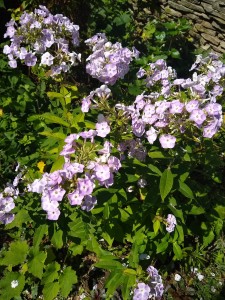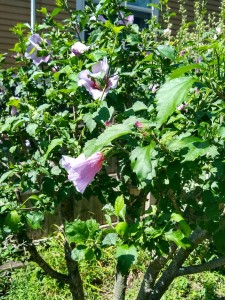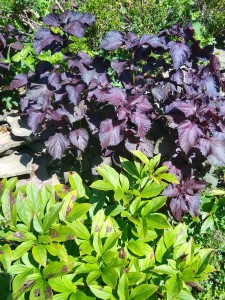 The rock band Deep Purple was formed in the late 1960’s and named after an old, popular English song. The first line of that song goes, ‘When deep purple falls over sleepy garden walls…” The rest is a wistful remembrance of lovers coming together as day fades to night.
The rock band Deep Purple was formed in the late 1960’s and named after an old, popular English song. The first line of that song goes, ‘When deep purple falls over sleepy garden walls…” The rest is a wistful remembrance of lovers coming together as day fades to night.
I think of “Deep Purple” because purples of all sorts predominate in my late summer garden. This is not strictly by design, but the result of various plants working individual magic in a serendipitous way.
When I bought my property I inherited five roses of Sharon, four of which had blue-purple flowers. That is a lot of big shrubs for a suburban lot. To keep them from hogging all the available garden space, I moved them around and trained a couple to grow as standards or tree-form specimens. If I hadn’t been vigilant about grubbing out the omnipresent rose of Sharon seedlings, I would now have a rose of Sharon farm, not a garden. No doubt purple or blue-purple would have predominated, but everything else—texture, contrast, breathing room—would have gone by the wayside.
Now, in the second half of summer, the roses of Sharon keep colorful company with the rosy purple flowers and dark purple stems of the equally prolific Joe Pye-weed. If you are not familiar with Joe Pye, take a drive out in the country. On the edges of road shoulders and farmers’ fields, you will see some tall plants—up to seven feet sometimes—topped by slightly rounded flowerheads. A closer look would show the tiny fragrant flowers that make up those heads. Joe Pye weed, formerly known as Eupatorium purpureum, and now, thanks to the infinite wisdom of plant taxonomists, known as Eutrochium purpureum, is a native plant. No matter what you call them, the blooms are pollinator magnets. In my garden, at least two monarch butterflies, plus assorted cabbage whites, swallowtails and skippers circle the Joe Pyes perpetually.
Like rose of Sharon, Joe Pye is incredibly prolific and you have to watch over it carefully to curb its invasive tendencies. You can also chop it back around Memorial Day, and even once again after that, to keep it from reaching skyscraper height.
All of that being said, it harmonizes well with just about anything in the garden and makes a great contribution to a predominately purple color scheme.
In sunny corners the roses of Sharon and Joe Pyes are nicely complimented by a purple-flowered butterfly bush that is just finishing its most recent flush of bloom, and a few purple coneflowers. I am hoping to acquire more of the coneflowers because they are useful, long-blooming perennials that work well in the role of mid-border midi skirts, covering the unattractive knees of plants like Joe Pye weed.
Without a doubt, the plant that ties all that purple together and reinforces the overall effect is the beautiful, prolific and incredibly annoying perilla mint or Perilla frutescens. I think the dark purple leaves smell like root beer. Some others detect spicy cinnamon notes. Known as shiso in Japanese cuisine, perilla has many applications in cooking. Used judiciously in the garden, it is a great filler, providing mounds or even sweeps of eye-catching color.
People visiting the garden often mistake perilla for one of the purple-leafed basils. Both are herbs and members of the mint family, but in general, I think the basils grow a little smaller and have better manners.
True to its minty DNA, perilla will flourish and reproduce just about anywhere—in beds, driveway cracks, lawns. Deer may eat all your sedums, but they will never touch the perilla, with which sedum, especially tall ones like ‘Autumn Joy’, go so well.
I like perilla because it is one of the few things in life that doesn’t inspire any guilt at all. I have pulled out scores of the purple plants without the slightest guilt twinge and congratulated myself afterwards for leaving behind attractive clumps. When those remaining perillas develop spikes of pink flowers they are even more decorative, and attract armies of pollinators. I try to remove the spikes just as they start to fade, because the trouble starts when perilla sets seed.
Except for the perilla, my purple plants will fade as fall approaches, giving way to the soft pinks, blues and whites of the asters. I will be ready, but for now, the butterflies and I are enjoying our extended deep purple moment.
